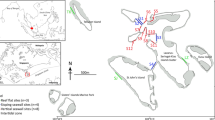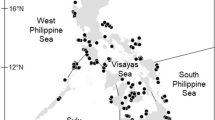Abstract
in 1974, 8 free-living coral species were found to inhabit the sandy sea floor adjacent to Lizard Island, Great Barrier Reef (14°40′S; 145°78′E). They fall into two groups which colonize two dissimilar sediment types. Plant cover increases with depth and, because of its effect on sediment characteristics, is thought to be a significant factor affecting coral distributions. The shallower coarse to medium grain sediments (0.5 to 0.125 mm) are mainly colonized by Heteropsammia cochlea, Heterocyathus aequicostatus, Diaseris distorta, and to a lesser extent by Cycloseris cyclolites. The deeper sediments are made up of a biogenically derived coarse fraction (larger than 0.5 mm) combined with an equally high proportion of fine-grade material. Corals typically found on these sediments are: Trachyphyllia geoffroyi, Catalaphyllia jardinei, Cynarina lacrymalis, and Cycloseris patelliformis. The content of non-carbonate material in the sediments reflects the hydrodynamics of the area and hence the degree of sedimentation, i.e., traction, saltation, or suspension loads, the corals have to cope with. Depth of occurrence was found to predict local coral distributions but was not applicable to other regions. Other factors which are discussed in relation to coral distributions include: coral mobility, coral shape, the effect of an obligate sipunculan associate, Aspidosiphon jukesii, in Heteropsammia cochlea and Heterocyathus aequicostatus, and settlement requirements.
Similar content being viewed by others
Literature cited
Ayyakkannu, K. and D. Chandramohan: Occurrence and distribution of phosphate solubilizing bacteria and phosphatase in marine sediments at Porto Novo. Mar. Biol. 11, 201–205 (1971)
Feustal, H.: Anatomische Untersuchungen zum Problem der Aspidosiphon-Heterocyathus-Symbiose. Verh. dt. zool. Ges., Jena 1965, 131–144 (1965)
Fisk, D. A.: Studies of two free-living corals and their common sipunculan associate at Wistari Reef (Great Barrier Reef), 201 pp. Master of Science thesis, University of Queensland, Australia 1981
Fisk, D. A.: Sediment shedding and particulate feeding in two free-living, sediment-dwelling corals (Heteropsammia cochlea and Heterocyathus aequicostatus) at Wistari Reef, Great Barrier Reef. Proc. 4th int. Symp. coral Reefs 2, 21–26 (1982). (Ed. by E. D. Gomez. Manila: University of the Philippines)
Flood, P. G. and G. R. Orme: A sedimentation model for platform reefs of the Great Barrier Reef, Australia. Proc. 3rd int. Symp. coral Reefs 2, 111–117 (1977). (Ed. by D. L. Taylor. Miami: School of Marine and Atmospheric Sciences, University of Miami)
Folk, R. L.: Petrology of sedimentary rocks. 159 pp. Austin, Texas: University of Texas Press 1974
Gill, G. A. and A. G. Coates: Mobility, growth patterns and substrate in some fossil and recent corals. Lethaia 10, 119–134 (1977)
Goreau, T. F. and C. M. Yonge: Coral community on muddy sand. Nature, Lond. 217, 421–423 (1968)
Guérin-Ancey, O.: Etude des intrusions terrigenes fluviatiles dans les complexes recifaux: delimitation et dynamique des peuplements des vases et des sables vaseux du chenal postrecifal de Tulear (S. W. de Madagascar). Recl Trav. Stn mar. Endoume (fasc. hors sér. suppl.) 10, 3–46 (1970). (Cited after Pichon, 1974)
Harry, H. W.: Correlation of benthic mollusca with substrate composition in Lower Galveston Bay, Texas. Veliger 19 (2), 135–151 (1976)
Hubbard, J. A. E. B.: Diaseris distorta an “acrobatic” coral. Nature, Lond 236, 457–459 (1972)
Orth, R. J.: The importance of sediment stability in seagrass communities. In: Ecology of marine benthos, 281–300. South Carolina: University of South Carolina Press 1977
Pichon, M.: Free living scleractinian coral communities in the coral reefs of Madagascar. Proc. 2nd int. Symp. coral Reefs 2, 173–181 (1974). (Ed. by A. M. Cameron et al. Brisbane: Great Barrier Reef Committee)
Pickard, G. L., J. R. Donguy, C. Henin and F. Rougerie: A review of the physical oceanography of the Great Barrier Reef and the western Coral Sea. Monograph Ser. Aust. Inst. mar. Sci. 2, 1–134 (1977)
Salvat, B.: Prospections faunistiques en Nouvelle Caledonie, dans le cadre de la Mission d'etudes des recifs coralliens. Cah. Pacif. 6, 77–119 (1964)
Salvat, B.: Etude preliminaire de quelques fonds meubles du lagon caledonian. Cah. Pacif. 7, 101–106 (1965)
Schindewolf, O. H.: Würmer und Korallen als Synöken zur Kenntnis der Systeme Aspidosiphon/Heterocyathus and Hicetes/Pleurodictum. Abh. math.-naturw. KL. Akad. Wiss. Mainz 6, 1–70 (1958)
Veron, J. E. N. and M. Pichon: Scleractinia of Eastern Australia, Part III. Monograph. Ser. Aust. Inst. mar. Sci. 4, 1–422 (1979)
Author information
Authors and Affiliations
Additional information
Communicated by G. F. Humphrey, Sydney
Rights and permissions
About this article
Cite this article
Fisk, D.A. Free-living corals: distributions according to plant cover, sediments, hydrodynamics, depth and biological factors. Mar. Biol. 74, 287–294 (1983). https://doi.org/10.1007/BF00403453
Accepted:
Issue Date:
DOI: https://doi.org/10.1007/BF00403453




